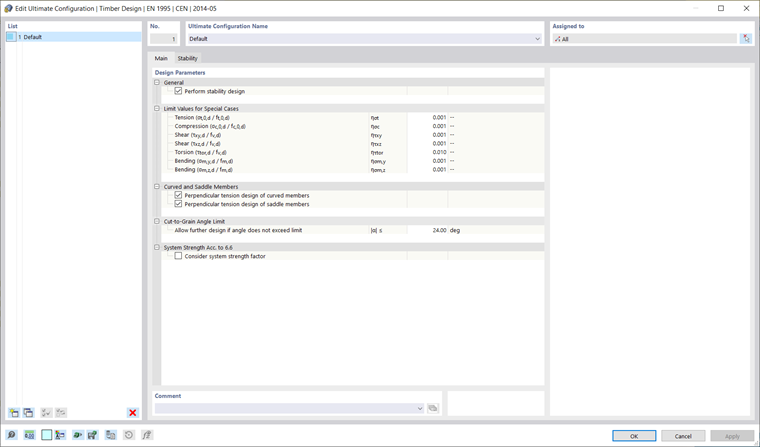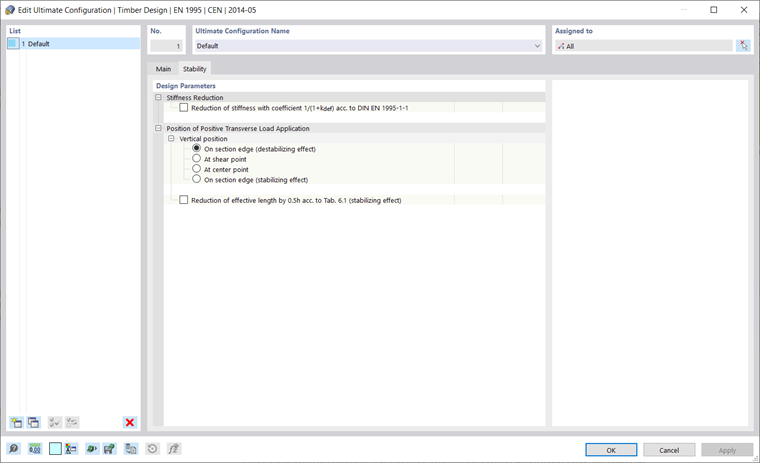In this dialog box, you can make the basic specifications for the ultimate limit state design. The basic structure of the dialog box for design configurations and the possibility of assigning them to the individual objects are described in the chapter Timber Design .
Main
In the Main tab, you can make various settings that affect the timber design checks.
General
The "Perform stability design" check box controls whether stability design checks are carried out in addition to the cross-section design checks. Deactivate this check box if you do not want to perform the stability design or if you have already considered the stability effects in the internal forces determination (for example, a calculation according to the second-order or large deformation analysis with imperfections).
If stability design is activated, it is necessary to specify effective lengths for the respective objects. If they are not assigned, a warning message appears in the result table of Errors & Warnings. Tension members are excluded from this warning, as only tensile forces can occur there by definition, and thus no stability design is required.
Limit Values for Special Cases
The design standards, which are often based on a manual calculation, often only allow design formulas or interaction conditions for certain combinations of internal forces. Within the context of a structural calculation on a 3D model, small values are often obtained for internal forces, which are not important for the load-bearing capacity from an engineering point of view, but which prevent certain design design checks or necessitate the use of less favorable interaction formulas if the design standard is strictly observed. Therefore, the Limit Values for Special Cases option provides a simple and transparent way of neglecting certain internal forces in the design in order to avoid the problems mentioned above.
The definition is done by specifying the section resistance component, which is determined in a simplified way via the cross-section properties. The limit ratios of the design resistance are derived from the standard specifications and preset with very small values in order to allow for simplified design. You should only use high limit values for testing purposes.
If an internal force is within the limit values, there is no further warning saying that it has been neglected now. In Design Check Details, the comment "Negligible" next to the respective internal force allows you to easily check which internal forces have been neglected due to the limit value settings and not considered in the design. If all internal forces are negligible at one location, the design check of the negligible internal forces is displayed at this location.
Further Options
Depending on the selected design standard, further options are available in the ultimate configuration. For example, deactivating the perpendicular tension design for tapers and curved members or changing the maximum cut-to-grain angle.
Stability
The Stability tab is available if Stability Analysis has been activated in the Main tab. Depending on the selected design standard, you can define further settings for the stability analysis here.
Load Application Point
If transverse loads are available, it is important to define the location where these forces are acting on the cross-section: Depending on the load application, transverse loads can be stabilizing or destabilizing, and thus have a major impact on the elastic critical moment for lateral-torsional buckling Mcr. First and foremost, the load application affects the eigenvalue solver for determining the critical bending moment, if this was selected as the determination type in the Effective Lengths. For members with constant cross-section, the load application also affects the definition of equivalent member lengths according to the footnote in Table 6.1 of EN 1995‑1‑1.
Further options are available, depending on the selected design standard.


